We are hiring postdocs, staff scientists, and a computing technician. If you are interested, please see our jobs page for details and reach out.
Category: Uncategorized
New Paper on Global Ant Diversity
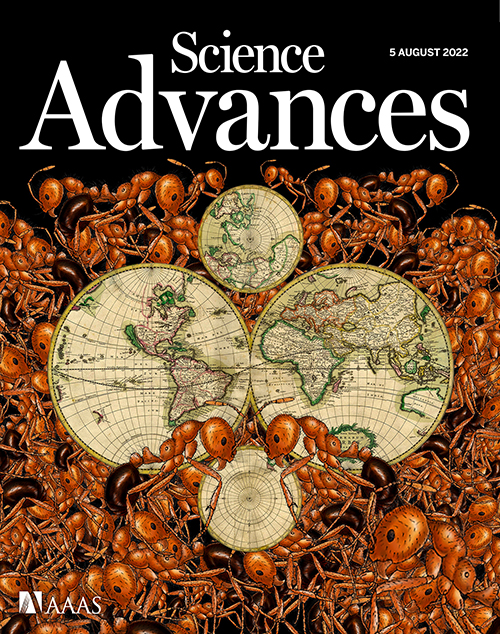
A long-term research goal of our lab is to build a comprehensive database and map of how ants are distributed around the world. We recently published a milestone in this effort, the first high-resolution mapping of richness and rarity. In this study, we compared ant patterns to vertebrates and used machine learning to predict hotspots of undiscovered diversity, which should help guide future research.
I explain more in a twitter thread and in an interview on the Science podcast.
The paper, led by first authors Jamie Kass and long-term collaborator Benoit Guénard can be found here.
Mainland fieldwork tales: of ants, earthquake, and fish cake
Guest post by PhD student Gaurav Agavekar.
One of the things I like about my PhD work is that I get to do a little bit of everything: fieldwork, molecular lab work, and bioinformatics. This helps keep monotony at bay and supplies a variety of interesting problems to solve. Although I like switching back and forth between these tasks, I probably enjoy fieldwork the most. Unfortunately, due to the pandemic, I haven’t had much of an opportunity to conduct fieldwork outside of Okinawa. Now that things are getting better pandemic-wise, I jumped on the opportunity to collect ants in mainland Japan.
Meeting the myrmecology legends in Japan
The week before last, lab technician Fumika Azuma and I embarked on a small field expedition to Manazuru forests in Kanagawa Prefecture, just south of Tokyo. My main goal was to collect some Strumigenys hexamera colonies, an Asian species without the iconic trap-jaw mandibles, but rather having the ancestral “gripping” mandibles. It’s known to reproduce parthenogenetically, which is why I wish to establish its colonies in the lab for our Strumigenys comparative genomics work. I was also hoping to collect some species that would serve as outgroups for this project, especially those not found in Okinawa.
Although S. hexamera occurs in Okinawa, I haven’t had luck so far in collecting this rather cryptic, soil-dwelling species. I thus reached out to Dr Keiichi Masuko, who I knew had collected it in the past, to seek advice for where I could collect some colonies. He generously offered to help us and tremendously facilitated the trip. Keiichi, a senior professor at the Senshu University, has been studying Strumigenys ants since before I was born! I was thus delighted to have an opportunity to discuss Strumigenys biology with him; over the years, he has made tons of interesting ecological and natural history observations on this fascinating group of ants, among others. Although Keiichi couldn’t join us in the field, he graciously requested Dr Mamoru Terayama to accompany us, who in turn obliged. Mamoru is a now-retired professor, who has vast experience in the systematics and taxonomy of Japanese ants and wasps. I was thrilled to be collecting ants with and visiting such giants in the Japanese myrmecology community.
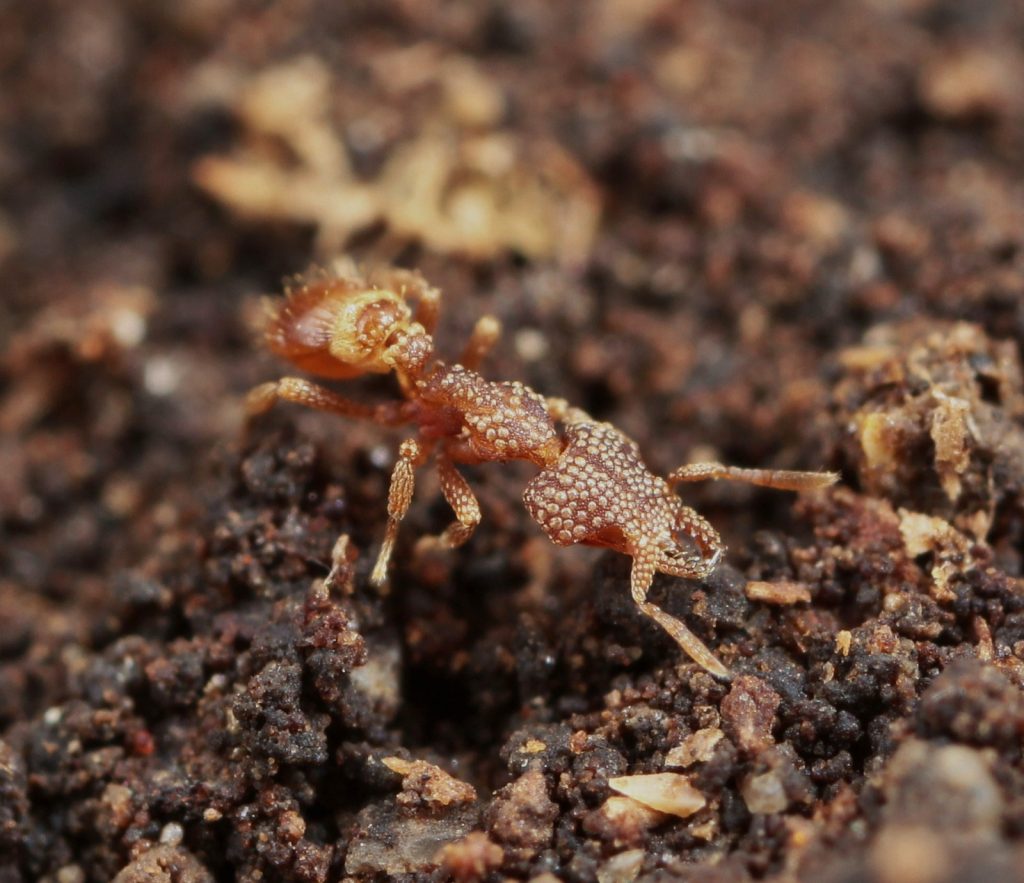
Fieldwork at Manazuru forests in Kanagawa
Boarding the blazing-fast Shinkansen train at Tokyo, we headed to Cape Manazuru, a 30-min drive south of the small city of Odawara in central Japan. Along the way to the cape is a forest patch of moderate size with trails built for adventurous citizens. Although the trails are rather short and not difficult to walk, the forest supports several species of evergreen trees that are quite huge in size. “The trees are at least 300 years old”, I was told by Keiichi. The difference in forests between mainland Japan and Okinawa was stark—the latter, although being more diverse, typically lacks such huge old growth trees because of widespread deforestation and frequent typhoons. The broadleaf evergreen trees in Manazuru forests are primarily camphor, black pine, Itaaji chinkapin, and cane.
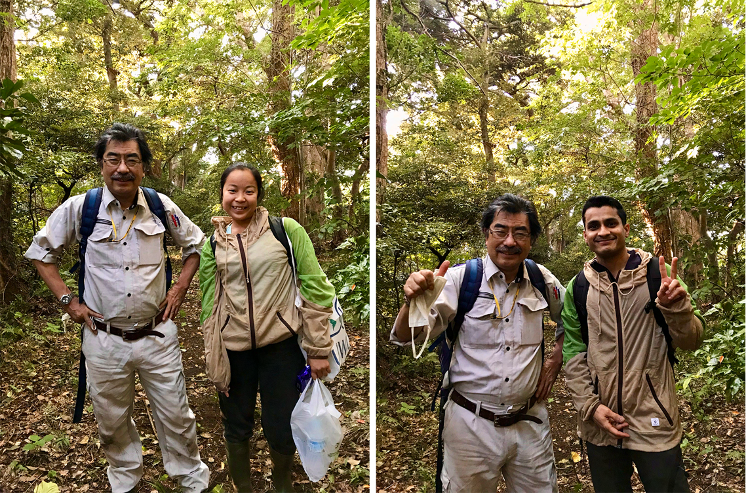
The soil arthropod community of the Manazuru forest is rich and abundant. As soon as we began searching, we found several colonies of Carebara, Nylanderia, and Hypoponera, the usual suspects in the ant world. Keiichi had told me that S hexamera nests ~10-20cm deep in the soil. It creates tunnels inside the soil and feeds on the abundant soil arthropods of the forest. Although I had never dug this deep before while looking for Strumigenys, and had mainly been focusing on taking apart rotten logs and flipping rocks, I quickly realized what kind of soil Keiichi was talking about. After digging through 10-15cm of loose soil, I began to find large soil lumps that had clay-like consistency. This type of soil seems ideal for the ants to make tunnels and create compartments to house their brood. Sure enough, within the first hour of beginning fieldwork, I found my first Strumigenys colony. Because Strumigenys species are rather tricky to identify in the field if you haven’t collected them before, I showed it to Mamoru, who immediately confirmed its identity as S hexamera. How exciting! Another highlight of the day included a Discothyrea sauteri colony, which unfortunately only had a queen and one worker, so raising this colony is probably going to be a challenge, not to mention their peculiar diet of arthropod eggs.
The next day we continued our efforts to find more Strumigenys colonies. We succeeded in collecting 5 more colonies, which included S canina and S incerta, neither of which I had collected before. We collected a bunch of other colonies, including a Myrmecina nipponica and Cryptopone sauteri, which might prove useful outgroups. We also collected a worker of Stigmatomma silvestrii, but unfortunately couldn’t locate the colony.
Meeting the members of the Myrmecological Society of Japan
Besides meeting Keiichi and Mamoru, we also had the great fortune of having dinner with Dr M Kondoh, the 87-year-old co-founder and current president of the Myrmecological Society of Japan. Dr Yamaguchi, a member of the Society, and his wife, both residing in Odawara, also joined us for the dinner.
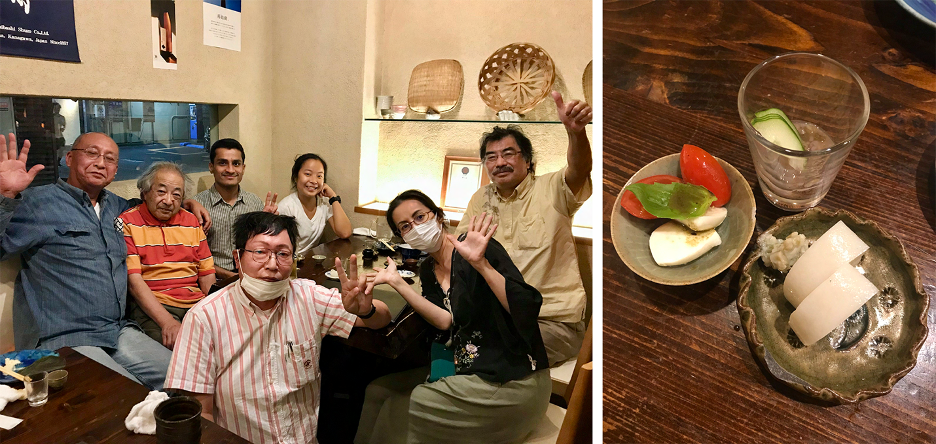
It was wonderful to get plugged into the Japanese myrmecologists community and hear stories about their work. The izakaya served a menagerie of delicious food, complete with Kamaboko fish cake, for which Odawara is famous in Japan. All in all, we had a great and productive time in the mainland. Besides these wonderful memories, the M6.1 earthquake I experienced in Tokyo will remain unforgettable. This was the most intense earthquake I have ever experienced and being on the 10th floor didn’t help either. Thankfully there was no tsunami or any damage from the earthquake, but those few seconds were unarguably the scariest of my life. Now back to the lab sorting those ant colonies…
Evan on Sabbatical
I am on sabbatical this year at Harvard University, where I was lucky enough be named the Mary I. Bunting Fellow at the Radcliffe Institute of Advanced Study. The fellowship program includes 50 scholars to reside here for a year and work on projects in an interdisciplinary environment. The fellowship program has a heavy weight toward Humanities and Social Sciences, which is a great change of pace after being at Natural Science-only OIST for the past years. But luckily they let a few biologists in too (I think every day, at least one must have been by mistake). It’s been fantastic so far to spend time with this amazing group of people at Radcliffe, not to mention some great colleagues and collections at the Museum of Comparative Zoology.
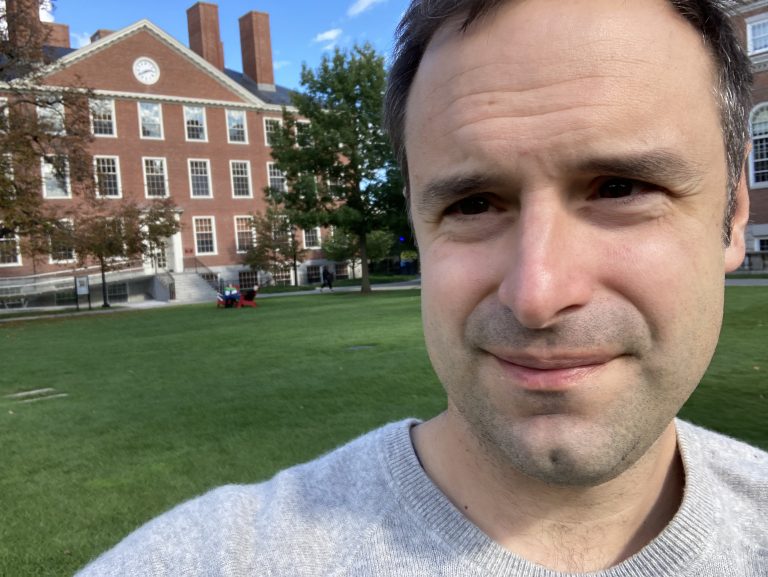
Mary I. Bunting, for whom my fellowship is named, was an incredible person. She was a successful microbiologist in a time when when women faced innumerable struggles in being professional scientists. She is best known, however, for her time as president of Radcliffe College when it was a women’s college (versus the all-male Harvard). She was instrumental in highlighting how society had a “climate of unexpectation” for girls and women and contributing to the progress we made toward greater gender equality in the decades since. Both Mary Bunting and Radcliffe have also played important roles in promoting women in academia over the years. In my time at OIST, on the GEDI (Gender Equality, Diversity, and Inclusion) committee, and as Associate Ombudsperson, I have learned a lot about gender and diversity issues that arise in academia, and even more so how those can be amplified in multicultural environments such as OIST. This are better than they were in Mary Bunting’s day, but there is still a long way to go. After 20ish years in academia, I still often notice problems and barriers that contribute to a lack of diversity our fields, many that I had not seen even though they were in plain sight (“A way of seeing is also a way of not seeing”-Kenneth Burke). During my fellowship I will be not only pursuing my “normal” biology research, I will be studying, learning, and thinking about how we can continue to make progress toward a more diverse and inclusive academia. I will bring what I learn back to our lab, OIST, and beyond.
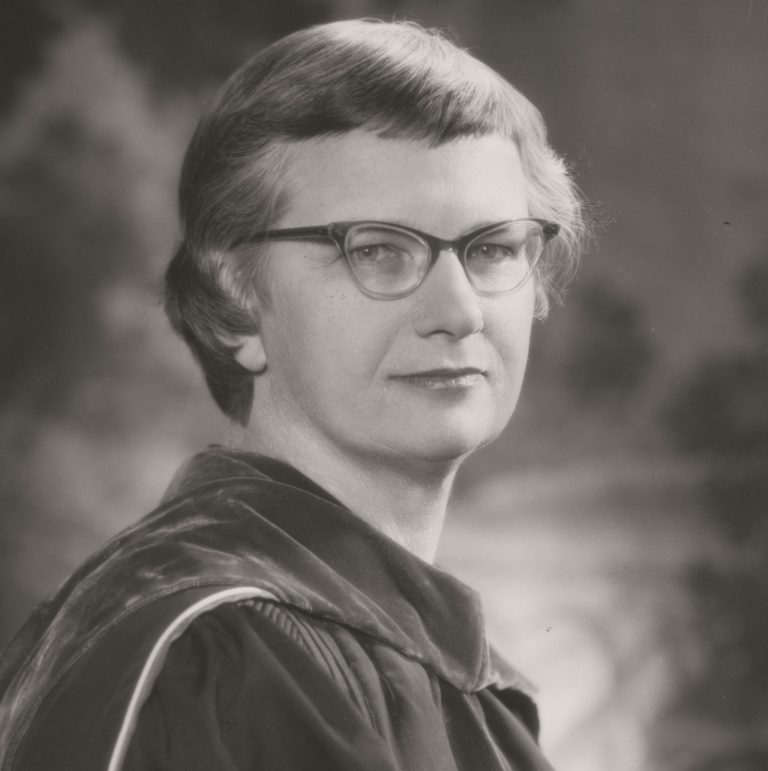
All about those mandibles
One of the most striking features of ant diversity is the sheer variety and ingenuity of mandibles. Mandibles are a primary way that ants interact with the world, and are used as diverse tools for many tasks and purposes. Ant mandibles are cutters and carriers, but also trap-jaws, snap-jaws, millipede shavers, seed millers, wood borers, and beyond. There are truly a huge number of mandible shapes and functions to explore from ecological, evolutionary, biomechanical, and developmental perspectives. We have a number of projects with collaborators ongoing about these interesting structures, here’s a little tour:
First up here’s a broad look at the diversity of ant mandibles, segmented from micro-CT scans by our PhD student Julian Katzke. Julian is doing his thesis surveying the diversity of mandibles, building a massive dataset across the tree of life, and analyzing their evolution. How many morphotypes are there, how many times have they evolved? Are there macroevolutionary pathways for their evolution (i.e. certain shapes tending to evolve into other shapes)? Julian is working on it.

A related topic is the structure of the muscles inside the head and its supporting endoskeleton. In scanning ants, we have found there is at least as much diversity in these structures inside the head as the mandible outside. Julian is working on analyzing that too.

Within that diversity, there are some really interesting innovations and adaptations. A major project in the lab in the past years is the evolution of Strumigenys trap jaw ants. Strumigenys are a globally distributed, hyperdiverse group with a variety of mandible types.

We found the trap-jaw mechanism has evolved between 7-10 times, and identified functional stepping stones that could explain how it may have evolved. Read the paper (Booher et al. 2021, PLoS Biology) and see Evan’s twitter thread to dig into this more.
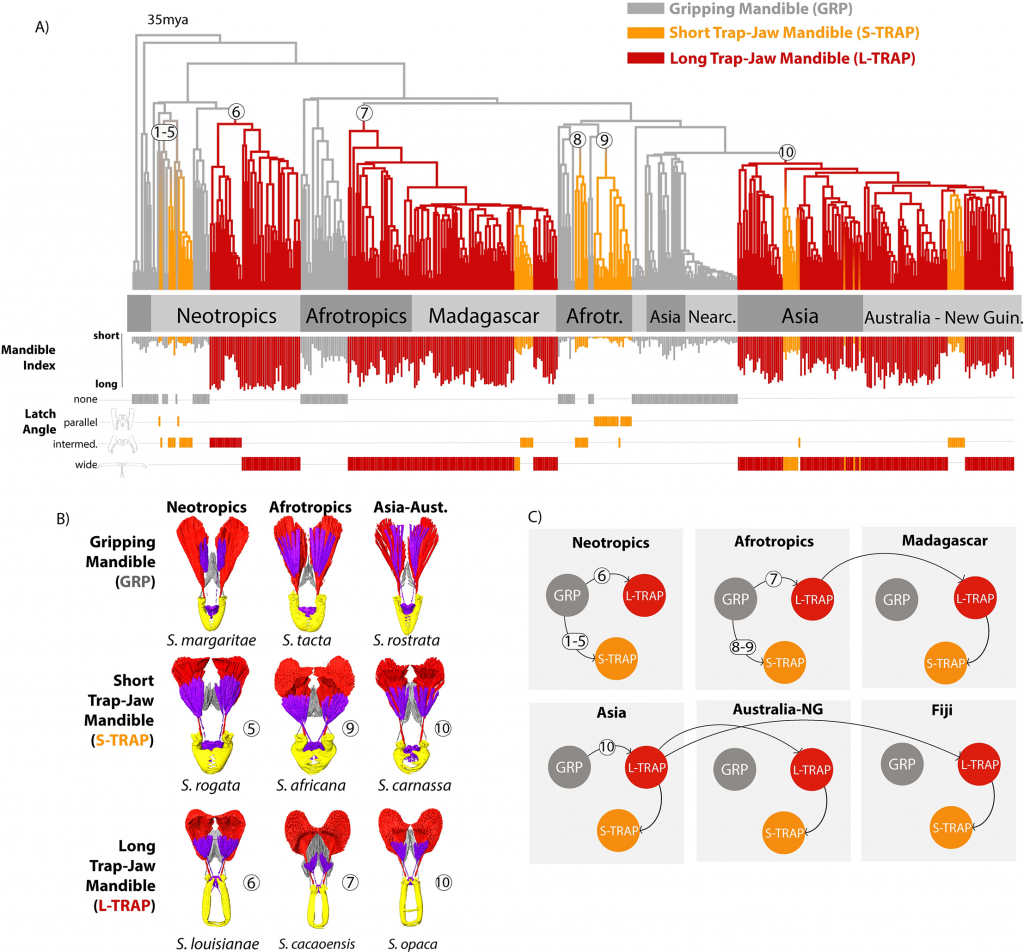
PhD student Gaurav Agavekar is following this up by investigating the genomic and developmental basis of this convergent evolution.
Another recent collaborative study focused on the wood-boring ant, Melissotarsus, the only ant to live completely in tunnels it carves in living wood, and one of the wildest ants out there. We found a number of adaptations to help chew through living wood, including changes to head musculature and interesting conical mandibles. This study was led by Adam Khalife and the late Christian Peeters, was published in Frontiers in Zoology.

And there are other mysterious species, such as Protanilla lini which has a very odd mandibular articulation with the head. Some think it may have a power-amplifying function, however this is still unclear. We recently looked at this species in a study led by Adrian Richter in collaboration of our lab. Julian made an animation of head movement to try to understand it.

Aside from these more exotic examples, we still lack a basic understanding of what axes of morphological and functional variation underlie normal triangular mandibles. How does shape vary with ecology and performance? Two recent studies help shed light on this.
First, our now postdoc Ale Casadei-Ferreira and colleagues analyzed ecology-mandible correlations and integration in the evolution of mandibles and head shape, focusing on Pheidole majors and minors.
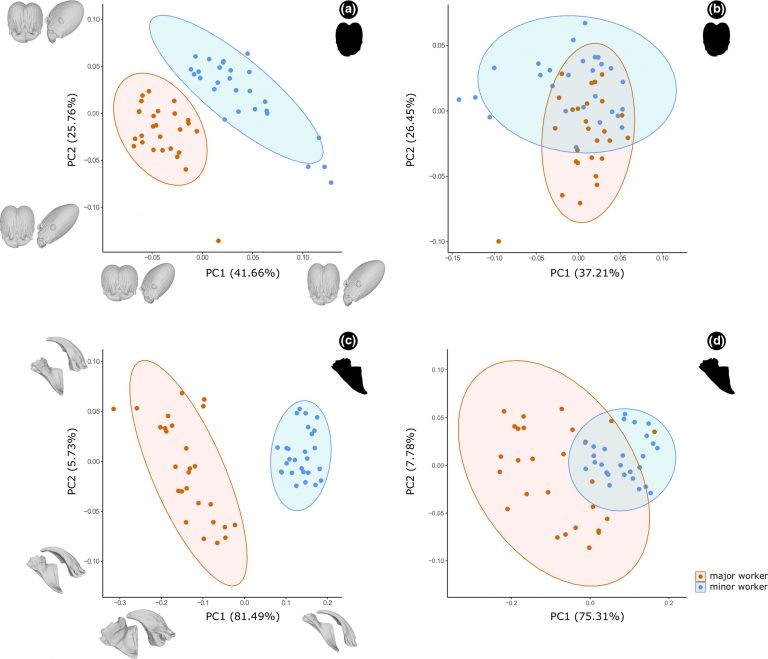
Second, Christian Klunk and colleagues used finite element analysis to analyze Pheidole mandibles, helping to understand how different mandible shapes reflect tradeoffs in force vs. speed, and how stress moves through the mandible shapes.
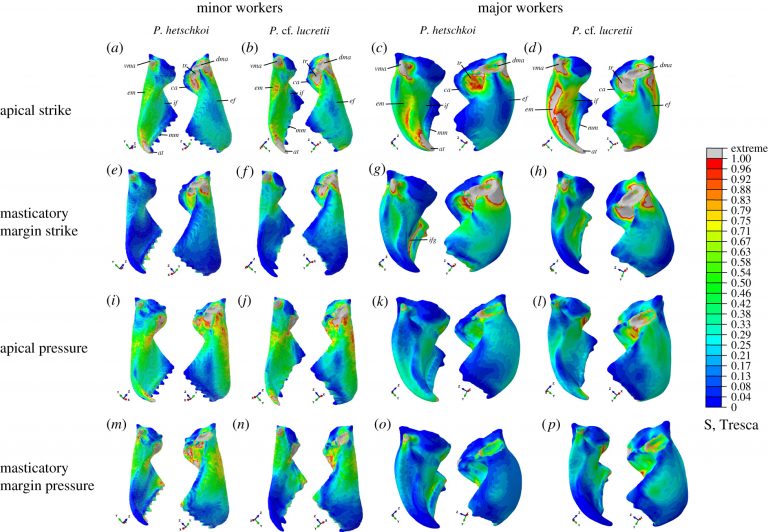
For more general discussion of the mandibles in context of the head, recent papers by Adrian Richter and various collaborators surveying the head anatomy of different ants are a must-read.
Of course there is lots of other great work going on out there by other labs, for example a terrific recent study by David Labonte’s lab on bite force allometries in Atta leafcutter ants.
There’s much more to come from our lab and others on the morphology, functional ecology, evolution, and development of these diverse tools ants use to interact with the world.
